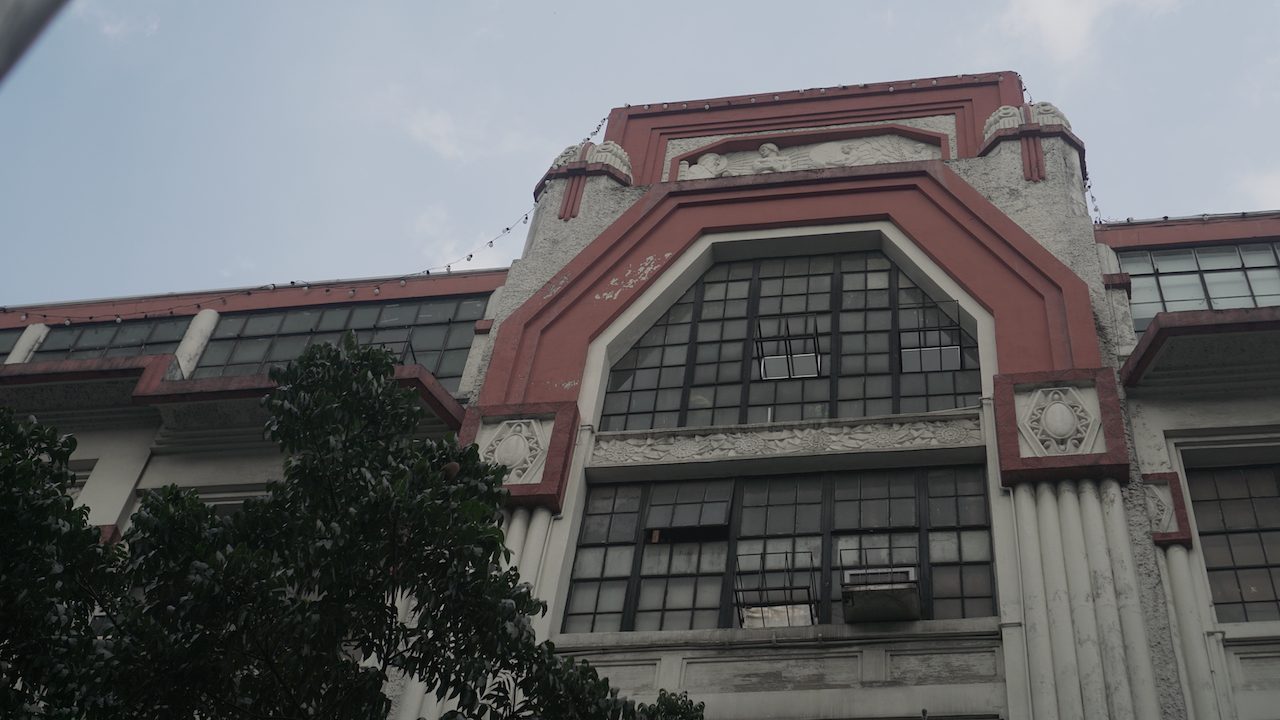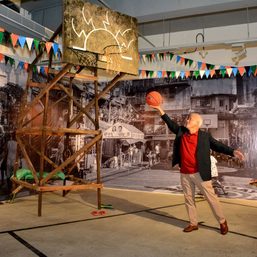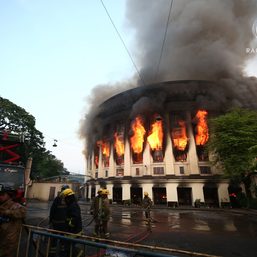SUMMARY
This is AI generated summarization, which may have errors. For context, always refer to the full article.

MANILA, Philippines – The First United Building in Manila’s Escolta district is a familiar sight to professionals and weekenders who frequent the area. Stately and well-kept, it stands out amidst Escolta’s derelict landscape, an embodiment of art deco beauty.
On the building’s facade, there is a marker that tells its story. Also known as the Perez Samanillo Building, it was completed in 1928 based on the design of Filipino architect Andres Luna de San Pedro, then sold to Jose Cojuangco, father of former president Corazon Aquino, in 1968.
Through the decades, ownership of the building changed hands until 1979, when it went to Chinese businessman Lian Teng Sy, who bought Berg’s, the department store that set up shop on the building’s ground floor.
Today, the building is co-owned and managed by Lian Teng Sy’s son Robert Sylianteng and his wife Lorraine, who have revived the building as a sort of hipster haven in Escolta, home to an artist’s collective, boutique coffee shop, a craft market, a co-working space, a community museum, and pre-pandemic, ground zero for the well-loved Escolta Block Party. As a small concession to capitalism, EastWest Bank takes up the building’s ground floor.

“We just wanted something different, not run-of-the-mill and boring,” Lorraine told Rappler.
The revival of the First United Building went hand-in-hand with the revival of the Escolta district, which began sometime in 2011. However, keeping an old building alive was not without its challenges.
“Old buildings are very hard to repair,” Lorraine said. “When you see a leak, it’s not just there, you have to practically open up the whole wall to see where the leak comes from. We often also get water seepage when it rains hard because of the many cracks on the wall. We’ve had to divide our rooms because nobody would take big rooms…. We have tenants who want to build partitions in their spaces. But they just nail right into the Machuca tiles which causes the whole tile to crack. Each tile costs us P100 to replace,” she shared.
Robert added that the estuaries and storm drainage around their building isn’t properly maintained, leaving them to become breeding grounds for rats and mosquitos.
“For lack of money, heritage property owners are victims of mosquitos and rodent-borne diseases,” he said, adding that they’ve tried to get support from the local government, but to no avail.
Facing these challenges, the Syliantengs were unaware they were entitled to certain protections as owners of an Important Cultural Property (ICP) under the National Cultural Heritage Act of 2009 or RA 10066.
In fact, they were not even aware that the building they struggled to maintain had been declared an ICP by the National Museum in 2013.
The National Cultural Heritage Act
According to RA 10066, an ICP is “a cultural property having exceptional cultural, artistic, and historical significance to the Philippines, as shall be determined by the National Museum of the Philippines and/or National Historical Commission of the Philippines [NHCP].”
Unless otherwise declared, works by a National Artist are presumed an ICP. The designation “Important Cultural Property” itself implies that its preservation and care is given a degree of priority, and by law, such properties are afforded certain protections, particularly “against exportation, modification, or demolition.”
For instance, immovable cultural properties declared National Cultural Treasures (NCTs) or ICPs should be given an official heritage marker, which would be placed on the property.
More than this, “the NCCA will give due notice to the concerned Registry of Deeds for annotation on their land titles. All cultural properties declared as NCT shall be entitled to priority government funding for protection, conservation, and restoration. All cultural properties declared as ICP may also receive government funding for its protection, conservation, and restoration,” explained Patrick Lee, chief of the Cultural Properties Protection and Regulation Division (CPPRD) of the NCCA.
He added that conservation management plans would be prepared by specialists for properties declared as NCTs or ICPs for their preservation and protection.
Up until 2017, Lorraine did not know that their building was entitled to all these benefits. She shared that it was only through youth heritage advocate Stephen Pamorada that they learned of the building’s heritage status.
“In 2017, Stephen, a youth heritage advocate, informed us that then-councilor Yul Servo Nieto sponsored a bill that would give real estate tax privileges to declared heritage buildings in Manila. I told Stephen that we can’t avail of that exemption because we are not declared. But we were informed by Stephen that we were, in fact, declared by the National Museum as an Important Cultural Property in 2013. So we quickly applied for that exemption,” she said.
“However, at City Hall, excuses were given as to why we could not avail of the exemption,” she said. They were told that a former ordinance only grants tax exemptions to schools or hospitals, and that they were not purely a cultural property but also a commercial property because they lease space to a bank.
“We persisted and they finally agreed, with the stipulation that this exemption cannot be applied to previous years. We agreed,” she said. (Rappler tried to get in touch with the Manila local government unit or LGU regarding their heritage conservation efforts, but we have not gotten a response. We will update this story once we get a reply.)
At that time, the NHCP also expressed interest in declaring them an ICP.
“They have been wanting to declare us for some years already.” But the Escolta building owners felt that if they didn’t have any benefit, why would they agree to be declared? Lorraine said, “It was only after we got our tax exemption that we agreed to be declared by NHCP.”
The First United Building owners were able to claim their tax exemptions from 2018 to 2020. When the Manila administration changed, however, they were rejected for tax exemption again.
“We were told [again] that they cannot honor the exemption because we are not a purely cultural property,” she said.
Today, their struggles as heritage building owners continue. They get little support from the local government, despite being declared both by the National Museum and the NHCP.
Removing heritage status
Like the First United Building, the Ramon Cojuangco Building (RCB) is also protected under RA 10066, by virtue of who designed it. Located in Makati, the structure stands 15 stories high, imposing and severe, done in clean lines and concrete – the signature of its architect, National Artist Leandro V. Locsin.
It seems puzzling why a property that qualifies as an ICP would want to rid itself of the designation, but on May 5, 2022, the NCCA issued a notice to the public, saying that there was a petition to strip the RCB of its designation as an ICP.

According to the petition, PLDT plans to redevelop its offices into a “modern, ecologically sustainable, and open campus-type headquarters” but before it can do so, it needs the approval of the NCCA, by law.
PLDT argued: “The RCB does not demonstrate exceptional cultural, artistic, and historical significance,” saying that the building isn’t representative of Locsin’s work, and that it is “generic, nondescript, and purged of any references to local culture, tradition, climate, or identity of the place.”
Following PLDT’s petition, ripples of protest went through heritage conservation circles, with experts bristling at another heritage structure being altered for the sake of “modernization,” or demolished altogether – a story that’s all too familiar in Metro Manila.
In July 2000, the Manila Jai Alai Building – built in 1940 and once considered Southeast Asia’s Art Deco gem – was torn down after being deemed unsafe. Its demolition was approved by then-Manila mayor Lito Atienza.
The destruction of the Manila Jai Alai Building awakened the sentiments of people toward heritage conservation, and was described by Philippine Daily Inquirer writer Toti Villalon as “a national wake-up call for the importance of heritage.”
Nearly nine years later after that, RA 10066 was signed into law.
Among its objectives is to “protect, preserve, conserve and promote the nation’s cultural heritage, its property and histories, and the ethnicity of local communities.”
However, based on the experiences of heritage building owners and stakeholders, what’s on paper is hardly put into practice.
Support
What kind of tangible support do heritage building owners like Lorraine hope to get from the government?
“They can give incentives as they did earlier. First, give us real estate tax incentives but require building owners to show how they spend the incentive. Second, give the businesses who support us or rent from us discounts on their business permit. Third, if we want to improve something, like paint the building, they should not charge us extra for building permits,” she said.
Patrick himself also said that the NCCA has to work on realizing RA 10066’s promised protections for heritage properties.
“For now, the NCCA still has yet to establish a system that will ensure that owners of declared heritage properties have access to the benefits, primarily because of very limited resources to do this,” he said.
“Indeed, it is part of the next steps the NCCA intends to do. As a national agency that lacks satellite offices in the regions, we need to engage regional government offices to assist us in making sure that RA 10066 is implemented,” he added.
Heritage architect Richard Tuazon Bautista told Rappler that even with a heritage law in place, its implementation remains on a case-to-case basis, and depends on how local governments understand and interpret it.
“A lot of LGUs hindi pa naiintindihan ang heritage law (still don’t understand heritage law). For them it’s just the usual thing; people are doing what they’re used to doing,” he said.
He explained that there would be no need for a heritage law if people were properly educated in the value of heritage conservation and the importance of preserving heritage structures. For him, people need to know the value of heritage, beyond just tourism.
“For many, the sad part is they see heritage as tourism, but not really in different disciplines,” he said.
Importance of heritage
Richard explained that people may not be able to immediately see the effects of heritage structures on the environment, but it’s important to understand why they are integral to their surroundings, not only because they give people a sense of identity and pride, but also because they encourage discipline.
“We try to know why we are like this through heritage. It’s a document that’s not written. It reflects what transpired,” he said.
“When you see the structure, you tend to follow a certain movement. It directly correlates people’s attitude, the personality, structure,” he said. “Ugliness breeds crime and violence.”
“Architecture has a discipline-forming thing. Try to notice. There are buildings that make you shut up, there are buildings that make you feel boisterous. There are certain lines that affect people psychologically. There’s this air of…something’s telling me I must not do this,” he said.
For him, conservation efforts must come from both private citizens and the government working together.
“If the locals are really keen on protecting it, the LGU must learn from it. The LGU might be keen without the locals or not, but [heritage conservation] should really be…it should come from both sides,” he said.
With private citizens exhausting means to keep their heritage structures intact, it seems that the onus is now on the government to match their efforts.
While NCCA may be struggling to protect heritage structures due to “limited resources,” owners of heritage buildings have managed to look past any financial limits.
“You know for us also, it’s not all about the money, the gratification of earning the money,” Lorraine said.
She shared that in First United Building’s community museum, they have a notebook where visitors can leave messages.
“We have read so many…minsan nga nakakaiyak ‘yung notes (sometimes the notes bring tears to my eyes). They write about appreciating what we’re doing, and getting inspiration,” she shared.
“There was once a guy who was let go of his architectural job and he was so down, he wanted to go to Sta. Cruz Church. On the way, he passed through First United Building…. He saw what we were doing and he said he was so inspired now and he was going to go on and continue to be an architect,” she shared. “Those things are very, very precious to us.” – Rappler.com
Add a comment
How does this make you feel?
![[Ilonggo Notes] Taking a heritage walk along Roxas City](https://www.rappler.com/tachyon/2024/06/provincial-capitol2.jpg?resize=257%2C257&crop_strategy=attention)










![[OPINION] Dipolog City: Is it modernization or cultural revision that’s happening?](https://www.rappler.com/tachyon/2024/07/dipolog-feature-july-6-2024.jpg?resize=257%2C257&crop=0px%2C0px%2C720px%2C720px)
![[Time Trowel] Yamashita gold is a myth, and treasure hunting is not archeology](https://www.rappler.com/tachyon/2024/06/myth-yamashita-treasure-june-14-2024.jpg?resize=257%2C257&crop=435px%2C0px%2C1080px%2C1080px)
![[Time Trowel] Safeguarding the Ifugao Rice Terraces for future generations](https://www.rappler.com/tachyon/2024/05/batad-rice-terraces-may-25-2024.jpg?resize=257%2C257&crop_strategy=attention)
There are no comments yet. Add your comment to start the conversation.